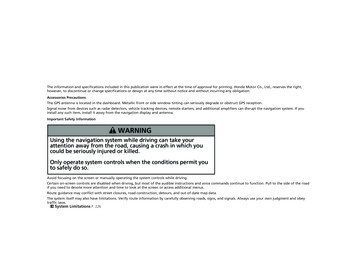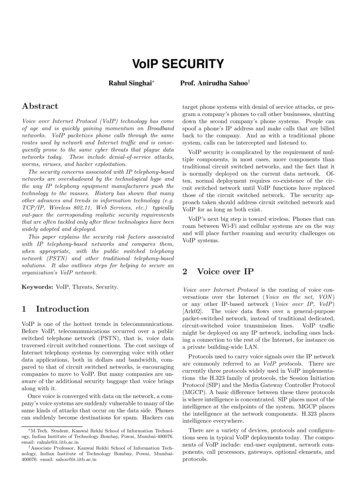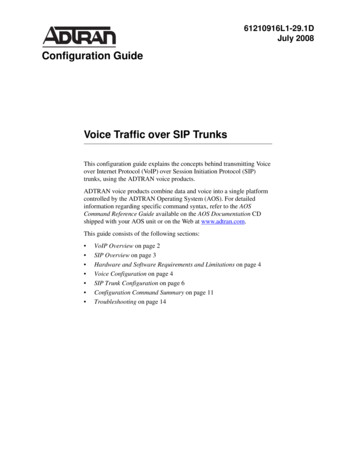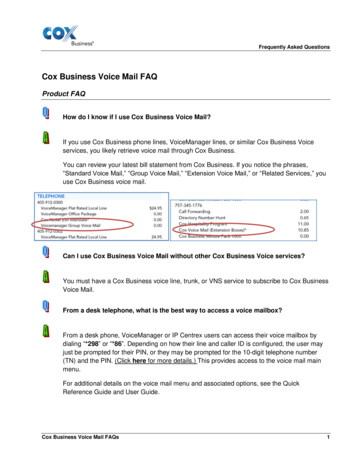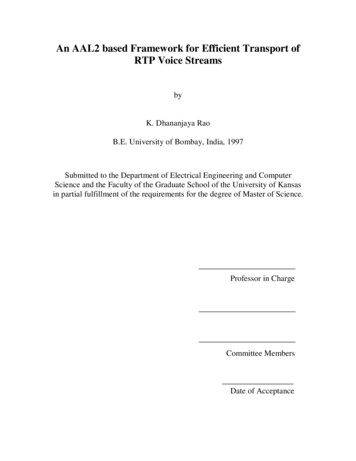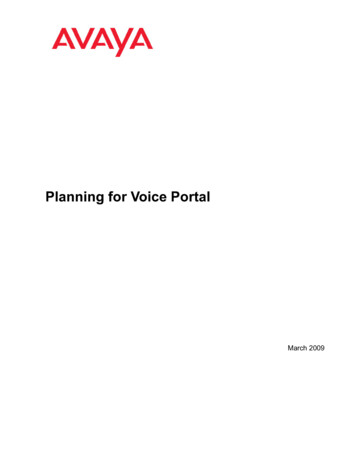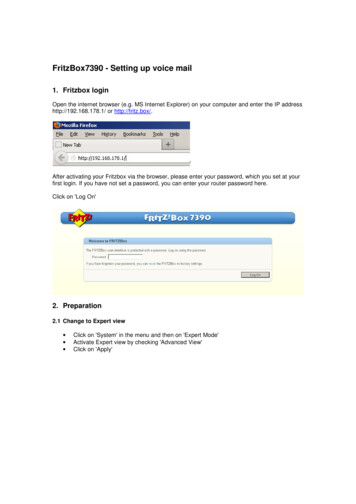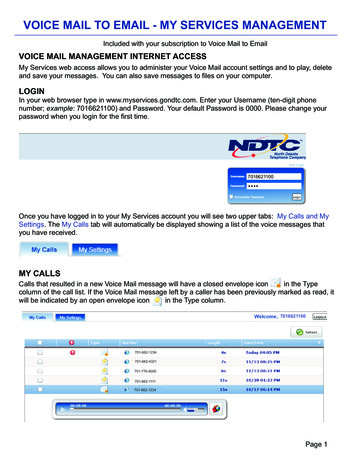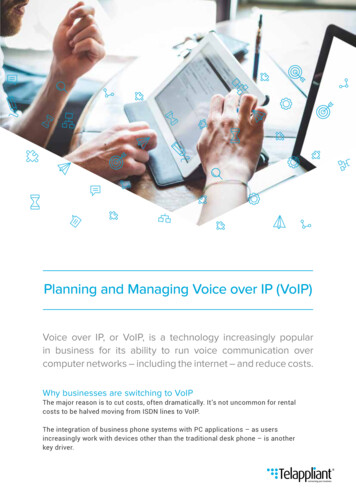
Transcription
Planning and Managing Voice over IP (VoIP)Voice over IP, or VoIP, is a technology increasingly popularin business for its ability to run voice communication overcomputer networks – including the internet – and reduce costs.Why businesses are switching to VoIPThe major reason is to cut costs, often dramatically. It’s not uncommon for rentalcosts to be halved moving from ISDN lines to VoIP.The integration of business phone systems with PC applications – as usersincreasingly work with devices other than the traditional desk phone – is anotherkey driver.
The benefits of VoIPVoIP eliminates some of the limitations oftraditional telephony by replacing high cost,specialised and proprietary hardware with lowcost services and commodity hardware. VoIPis far more scalable both in terms of users andlocations.Traditional telephone lines are inefficientsince a pair of physical copper wires is neededfor each concurrent call, and these lines areutilised only when a call is made. Since VoIPcalls run on existing computernetworks, investment in broadband or leasedline connections is maximised by eliminatingISDN rental charges.VoIP also brings new featuresincluding: video calls and video conferencing high definition voice calls integrated collaboration tools likeinstant messaging and presence.What about Skype?Skype is a form of VoIP that operates on PCs, tablets and mobiles over the internet.It’s a peer-to-peer system that uses participating PCs to process and carry calls.Being internet based, Skype has no network infrastructure of its own and so the costbase is cut – but this also means that the quality of calls can’t be controlled.Skype is generally seen as a service aimed at the consumer market, in particularfor international video calls. As such it doesn’t yet provide the range of services that businessesusually expect, for example extensions, call hold and forward and voicemail.
Potential costsCostOne off or recurringTypical amountVoIP telephonesOne-offTypically 50- 200 per unitInstallation costsOne-offDependant on local networksurveyEnd user licencesVariableVariable by system choiceFeature chargesVariableVariable by packageCall costsRecurringMostly per-secondConnectivity; ADSL(includes line rental oflandline) or leased lines.RecurringVariable by provider. Can oftenleverage existing connectivityarrangements.SIP trunksRecurringVariable by packagePBX servicesRecurringVariable by packagePotential savingsSavingOne off or recurringTypical savingsISDN circuitsRecurringLine rental can typically be halvedInter-branch callcostsRecurringUsually un-metered (i.e. free)Call costsRecurringVariable by service providers, but VoIP isalmost always the same or better valuethan PSTNHome workingRecurringContingent on the value of phonesoperating at home as in the officeBusinesscontinuity &disaster recoveryRecurringContingent on the value of being able toset up phones anywhere with an internetconnectionFlexibilityRecurringContingent on the value of adding andremoving extensions and services at willPBX maintenancecostsRecurringHosted systems require no maintenancePBX Capital Cost(avoided)One-offPhysical PBX typically 5,000
Planning for implementationTelephone numbersWhilst we’re familiar with geographic telephone numbers, with VoIP both geographic andnon-geographic numbers can be delivered anywhere, by porting existing numbers to a SIPprovider (SIP is a standard for voice and multimedia calls using the internet and other computernetworks in place of the traditional telephone network (PSTN). In addition to the cost savingsand functionality enhancements, this also provides a way for businesses to retain telephonenumbers if moving offices to another area.Hosted servicesA private branch exchange (PBX) telephone extensions within an office. It typically serves asingle physical location.Today’s hosted PBX services do away with the hardware required on-site. Instead, theyoffload the functionality to a service provider (increasingly referred to as a cloud solution).As a result, personnel can easily work across locations, since the hosted PBX doesn’t care wherea telephone is physically located, in the same way that email can be picked up anywhere.
An interesting and useful side effect of hosted VoIP servicesbeing location independent is that it considers all calls between itsextensions as internal, regardless of physical location. For smallercompanies, this can create the perception of a larger organisationand also means that calls between extensions are unmetered, evenif they are separated by thousands of miles.Handset options and provisioningSeparating voice and dataA wide range of telephones are available,from 50 to 500 or more, with featuresand functionality designed for every usecase from individual consumers to largeinternational businesses. Soft phones an app that runs on a PC, smartphoneor tablet - are also generally available.Because speech data is real-time, normalcomputer-network transient conditions (suchas packet loss, latency, and jitter) do impactVoIP call quality. It’s therefore important for theprovider to understand the nature of the networkand offer robust solutions such as class-ofservice prioritisation and VLANs to separatetraffic types.It is usually recommended to acquire phonesfrom the VoIP solution provider, since someconfiguration is required and differenthandsets often have different system licensingimplications.Network requirementsBroadband typically has more download capacitythan upload, and since telephone calls need equalcapacity in both directions, the lower (upstream)capacity is the limiting factor, determining howmany simultaneous calls are possible. Generally,a couple of phones and PCs can be used ona standard business broadband connection,and a dedicated broadband connection shouldbe able to support ten or more phones.CodecsThe actual bandwidth each concurrent callneeds depends on the codec used (the methodof converting voice to digital data), alternativesproviding a trade-off between audio quality,bandwidth and compatibility. Calls of the samequality as a PSTN line need about 100kbpseach, but that can be halved at the expenseof some audio quality by using a compressedcodec.The final design depends on the networkinfrastructure already in place, securityrequirements, and of course budget. For largersystems, a detailed network assessment willbe needed.SIP trunksSIP trunks use the SIP standard to connect VoIPsystems to the outside world, enabling calls to bemade to and received from any other telephone.SIP trunks can carry many simultaneous calls,making it possible to reduce costs by replacingmany ISDN lines with a single internet connection.SIP trunks are marketed in various ways by VoIPproviders, from a free service associated withtheir telephone numbers or PBX, to a chargeableservice based on the number of simultaneouscalls or channels supplied. VoIP for the SolePractitioner and Small Firm.
Some forms of VoIP are targeted specifically at the smaller businessHosted VoIP services for this sector are capable of providing a range of telephony serviceswith low rental costs. In addition, numbers, extensions, services and features can be addedor removed as required, usually without penalty or the need for long term contracts - andsometimes, with no contract at all.Companies that specialise in services to small firms can be found in the Small Enterprisecategory on the ITSPA Awards website www.itspaawards.org.uk.Support, management and recoveryService provider supportA key benefit of hosted VoIP solutions is thatservice providers can offer more effectiveremote support, reducing costly site visits, sincethe major components of the system are locatedwithin their data centres. This also enablesmaintenance tasks such as software patchesand upgrades to be undertaken more regularlyand without downtime.The service providers also generally have realtime monitoring systems to alert them to faultsproactively, in contrast to traditional telephonyproviders who generally rely on fault reportslodged by customers.Online managementMany service providers have taken advantage ofinternet technologies to provide sophisticatedonline management tools or web control panelswith their VoIP services. These go further thantraditional PBX management tools by providinga range of real time information such as: itemised call records usage statistics autodials from your address books integration with online services suchas Salesforce.com and Google AppsOther features offer organisations better controlof their telephony- such as setting up callforwarding from a web interface. A businesswith multiple offices, home offices and mobileworkers can generally control the completeservice from a centralised online managementinterface.Disaster recovery and businesscontinuityVoIP can address the telephony side of DisasterRecovery and Business Continuity almost bydefault.Whilst companies using both SIP and ISDNchannels have the option of using one technologyif the other fails, many companies moving toVoIP will completely eliminate ISDN lines andachieve redundancy with combinations ofbroadband connections and leased lines fromdifferent providers. Failover between suchnetworks can then be achieved automatically.Multiple failover is also achieved by VoIP’s abilityto be easily redirected. In the event of somethingpreventing an office from working, the calls can betaken by another office.It’s usually possible for phones to be taken homeand used there. Even if the worst happens andan office burns down, preconfigured phonescould be shipped the same day, plugged inanywhere and work exactly as they did in theoffice.
Security and complianceSecurityRegulatory complianceHowever, VoIP systems, like anything elseconntected to the internet, are potentiallyvunerable to malicious use, so it’s esstential touse an ITSP with robust network security suchas dynamic fraud olutions require on-site recorders and storage,VoIP providers increasingly offer on-tap penceper-minute call recording services, making callrecording accessible to even the smallestbusinesses. reduce the carbon footprintassociated with traditional commuting. Audioand video conferencing can also reduce theamount of business travel. In its own right,unified communications is a green technology,requiring little hardware. Softphones, forexample, can replace handsets which wouldotherwise end up in landfill.Traditional PSTN calls can be intercepted bytapping the wires anywhere along their route,but intercepting VoIP calls usually requiresaccess to either the customers’ or serviceproviders’ premises. Because on-premises callinterception can be avoided through networkdesign and use of encryption, VoIP is concideredto be more secure than PSTN.Using reputable VoIP suppliers is also essentialbecause these companies all provide emergencyservices. However, it is important to note thatpower outages (without a UPS) and interruptionof internet connectivity will prevent emergency(999) calls being made with VoIP telephones - asit will with most normal PBXs.Where an advanced IP solution is deployed thatallows users to roam and ‘log in’ in other buildings,it is worth consulting your supplier regardingwhat 999 address information is automaticallypresented by your network operator in anemergency call.Companies that need to be FSA compliant oftenfind that the cost of initially achieving complianceand call recording. For businesses with multiplelocations, the costs of recording calls usingtraditional telephony is generally far higher thanwith a VoIP solution, since a single, centralisedrecording platform solution can be implementedwith VoIP.Similarly, unified communications is anapplication that can be easily deployed on theexisting network – it does not require a newserver or separate cabling. Software updatesare simply downloaded from the internet, whichfurther reduces carbon consumption by avoidingthe use of CDs, packaging and delivery services.
Calculating the return on investmentWhile the financial rationale for unified communications should be primarily based on thetotal cost of ownership, it is relatively quick and easy to calculate savings and therefore areturn on investment.Savings may arise from:Reduced travelling expensesUnified communications can significantlyreduce commuting and travel to meetings,saving both fuel and the cost of employeetransit.Reduced overheadsBy facilitating remote working, office space canbe minimised, which in turn will reduce costssuch as rent, lighting and heating.Reduced cost of audio and videoconferencingMany unified communication packages includethe option of audio and video conferencing,which will eliminate the need for additionalseparate expenditure.Reduced IT equipment costsAs previously covered, unified communications is asoftware-based application, which eliminates theneed to buy or update expensive IT equipmentand can actually replace desktop handsets.Existing IP handsets can also be integratedseamlessly into the unified communicationsenvironment.Improved collaboration, productivityand decision makingAlthough more difficult to quantify, thesebenefits can deliver vital strategic outcomesincluding quicker problem resolution, reducedtime to market, and improved customersatisfaction and knowledge sharing.Do’s and Don’tsDODON’TReview your local network and broadbandUse VoIP if your access to the internetaccess before jumping in.is poor.Your homework - Service providersCommit to long contractsaren’t all the same. Test your serviceprovider before committing - call theirTry to cut costs on hardware and Interentsupport line.access - your firm’s reputaion will bedamaged by poor call quality.Use a VoIP provider that is a member ofITSPA and preferably one that has earned aChoose separate providers for your phones,Quality Mark certification.SIP trunks and broadband. (Unless you likeplaying pass the parcel).
About TelappliantTelappliant has been delivering internet telephonysolutions since 2003. It is a founding member of theInternet Telephony Service Providers Association(ITSPA) and was one of the first companies tolaunch VoIP services into the UK SME market.Telappliant owns one of the largest VoIP networksin the country and through its flagship VoIP phonesystem, VoIPOffice Hosted, provides a reliabletelephony service to more than 20,000 businesses.VoIPOffice Hosted Professional is an IP PBX solutionhosted by Telappliant ‘in the cloud’. It provides lowcost calls at less than 1p per minute and enablesusers to enjoy the features and benefits of anadvanced business telephone system but withoutthe hardware and maintenance costs.Telappliant also offers a range of complementaryVoIP services. These include SIP trunking (VoIP‘telephone lines’), VoIP-optimised broadband, globaltelephone numbers and unified communicationssolutions.The company is fully ISO 9001 certified and uniquelypositioned to deliver state-of-the-art, integratedend-to-end solutions, with high quality businesssupport and dedicated account management.Get a quote for VoIPOffice,our cloud telephone system Get a quoteTelappliant Ltd.3 Harbour Exchange SquareLondon E14 9GEUnited Kingdom0345 004 4040 www.telappliant.com info@telappliant.com @telappliantbuzz
SIP trunks SIP trunks use the SIP standard to connect VoIP systems to the outside world, enabling calls to be made to and received from any other telephone. SIP trunks can carry many simultaneous calls, making it possible to reduce costs by replacing many ISDN lines with a single internet connection. SIP trunks are marketed in various ways by VoIP
